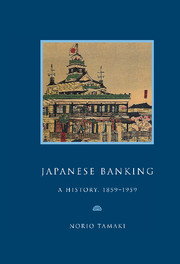Book contents
- Frontmatter
- Contents
- Preface
- Genealogy of leading Japanese banks, 1859–1959
- List of abbreviations
- Map
- Part I A bankrupt Shogunate, 1859–1868
- Part II The Meiji Restoration: monetary confusion and banking experiments, 1868–1881
- Part III Matsukata, the wizard of Japanese banking, 1881–1897; the Yokohama Specie Bank (1880) and the Bank of Japan (1882)
- Part IV The Japanese on the London money market, 1897–1911
- Part V War, the Japanese boom years, 1911–1919
- Part VI Crisis and the road to war, 1919–1937
- Historical background
- 21 Post-war collapse, 1919–1923
- 22 The 1923 catastrophic earthquake, 1927 financial disaster and the new Bank Act, 1923–1927
- 23 Financing heavy industries, 1927–1937
- 24 The challenge of militarism, and a change of roles for Nichigin and Shokin, 1929–1937
- Part VII Complete commitment, struggle and defeat, 1937–1945
- Part VIII American ‘democratisation’ and the search for growth, 1945–1959
- An extraordinary century, 1859–1959
- Appendices
- Notes
- Bibliography
- Index
21 - Post-war collapse, 1919–1923
Published online by Cambridge University Press: 03 February 2010
- Frontmatter
- Contents
- Preface
- Genealogy of leading Japanese banks, 1859–1959
- List of abbreviations
- Map
- Part I A bankrupt Shogunate, 1859–1868
- Part II The Meiji Restoration: monetary confusion and banking experiments, 1868–1881
- Part III Matsukata, the wizard of Japanese banking, 1881–1897; the Yokohama Specie Bank (1880) and the Bank of Japan (1882)
- Part IV The Japanese on the London money market, 1897–1911
- Part V War, the Japanese boom years, 1911–1919
- Part VI Crisis and the road to war, 1919–1937
- Historical background
- 21 Post-war collapse, 1919–1923
- 22 The 1923 catastrophic earthquake, 1927 financial disaster and the new Bank Act, 1923–1927
- 23 Financing heavy industries, 1927–1937
- 24 The challenge of militarism, and a change of roles for Nichigin and Shokin, 1929–1937
- Part VII Complete commitment, struggle and defeat, 1937–1945
- Part VIII American ‘democratisation’ and the search for growth, 1945–1959
- An extraordinary century, 1859–1959
- Appendices
- Notes
- Bibliography
- Index
Summary
Banking casualties and emergency measures, 1919–1922
The wartime boom in Japan was inevitably succeeded by recession. The turning point was 1919 and towards the end of the year foreign trade became sharply depressed. During the first quarter of 1920, imports exceeded exports by ¥260 million. This was a heavy blow, suggesting comparisons with the deficit year of 1905 when, during the Russo-Japanese War, the largest deficit during the first decade of the twentieth century was recorded. Japanese exports had ceased to sell abroad. Textiles were seriously hit and even silk, usually in steady demand, was by January 1920 unable to find good markets. The Japanese mercantile marine was badly affected as shipping rates fell by nearly two-thirds during the course of the year. The collapse of foreign trade affected the holdings of specie reserve which in Japan between 1919 and 1922 decreased from ¥2,045 to ¥1,830 million, an 11 per cent fall. More worrying, specie kept abroad, chiefly in London, which reflected most closely Japan's foreign trade position, fell 54 per cent, from ¥1,343 to only ¥615 million during the same period. Japan's disappearing specie was a matter for serious concern.
Bank of Japan interest rates, which had been at their lowest ever at 5.11 per cent in March 1917, were twice raised in an attempt to cure heated money markets and soaring prices and by March 1918 were at 6.57 per cent. In October and November 1919 the rates were further raised, eventually to 8.03 per cent, where they remained for more than five and a half years, a record.
- Type
- Chapter
- Information
- Japanese BankingA History, 1859–1959, pp. 140 - 146Publisher: Cambridge University PressPrint publication year: 1995

